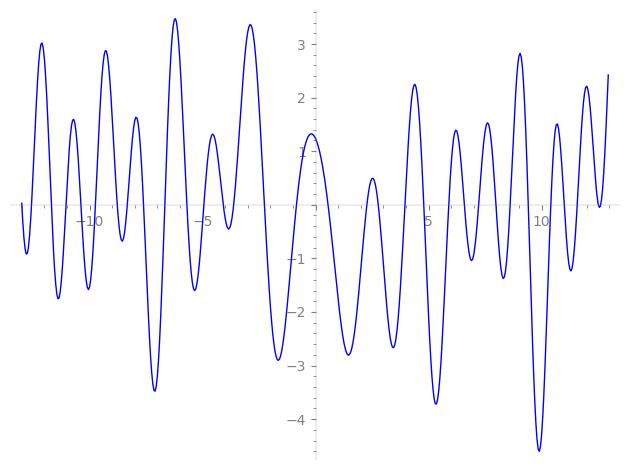| L(s) = 1 | + i·3-s + (−1.48 − 1.67i)5-s − 1.19i·7-s − 9-s − 11-s − 0.806i·13-s + (1.67 − 1.48i)15-s + 3.76i·17-s − 5.35·19-s + 1.19·21-s + 4i·23-s + (−0.612 + 4.96i)25-s − i·27-s + 4.31·29-s − 0.962·31-s + ⋯ |
| L(s) = 1 | + 0.577i·3-s + (−0.662 − 0.749i)5-s − 0.451i·7-s − 0.333·9-s − 0.301·11-s − 0.223i·13-s + (0.432 − 0.382i)15-s + 0.913i·17-s − 1.22·19-s + 0.260·21-s + 0.834i·23-s + (−0.122 + 0.992i)25-s − 0.192i·27-s + 0.800·29-s − 0.172·31-s + ⋯ |
Λ(s)=(=(2640s/2ΓC(s)L(s)(0.749−0.662i)Λ(2−s)
Λ(s)=(=(2640s/2ΓC(s+1/2)L(s)(0.749−0.662i)Λ(1−s)
| Degree: |
2 |
| Conductor: |
2640
= 24⋅3⋅5⋅11
|
| Sign: |
0.749−0.662i
|
| Analytic conductor: |
21.0805 |
| Root analytic conductor: |
4.59135 |
| Motivic weight: |
1 |
| Rational: |
no |
| Arithmetic: |
yes |
| Character: |
χ2640(529,⋅)
|
| Primitive: |
yes
|
| Self-dual: |
no
|
| Analytic rank: |
0
|
| Selberg data: |
(2, 2640, ( :1/2), 0.749−0.662i)
|
Particular Values
| L(1) |
≈ |
1.234408995 |
| L(21) |
≈ |
1.234408995 |
| L(23) |
|
not available |
| L(1) |
|
not available |
L(s)=p∏Fp(p−s)−1 | p | Fp(T) |
|---|
| bad | 2 | 1 |
| 3 | 1−iT |
| 5 | 1+(1.48+1.67i)T |
| 11 | 1+T |
| good | 7 | 1+1.19iT−7T2 |
| 13 | 1+0.806iT−13T2 |
| 17 | 1−3.76iT−17T2 |
| 19 | 1+5.35T+19T2 |
| 23 | 1−4iT−23T2 |
| 29 | 1−4.31T+29T2 |
| 31 | 1+0.962T+31T2 |
| 37 | 1−1.61iT−37T2 |
| 41 | 1−9.08T+41T2 |
| 43 | 1−4.41iT−43T2 |
| 47 | 1+12.3iT−47T2 |
| 53 | 1+1.42iT−53T2 |
| 59 | 1−13.2T+59T2 |
| 61 | 1+0.0752T+61T2 |
| 67 | 1−2.70iT−67T2 |
| 71 | 1−14.0T+71T2 |
| 73 | 1−10.7iT−73T2 |
| 79 | 1−13.9T+79T2 |
| 83 | 1+9.89iT−83T2 |
| 89 | 1+16.8T+89T2 |
| 97 | 1−11.4iT−97T2 |
| show more | |
| show less | |
L(s)=p∏ j=1∏2(1−αj,pp−s)−1
Imaginary part of the first few zeros on the critical line
−8.772725883677591832124471082981, −8.329018101570817948272871827236, −7.61036721483342525558845958042, −6.66890331415702974650305628050, −5.69306686036635602482810992159, −4.94105589999368435064477576306, −4.08364994614778861624053789734, −3.62362379909875747507960830670, −2.26356132652602173684245305026, −0.844845720571783865139902330449,
0.55298553805198929717913163165, 2.27021186737293786338344045180, 2.77368565703586902391053758035, 3.95386488446155801072114187920, 4.78768635491278309561050536293, 5.89284410021160953758037319343, 6.58401394103575596046598262579, 7.21657901981280274939950388017, 7.980851406146128205305365973755, 8.608759176960002325258124045259

